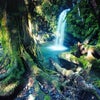The Plains of Abraham (French: Plaines d'Abraham) is a historic area within The Battlefields Park in Quebec City, Quebec, that was originally grazing land, but became famous as the site of the Battle of the Plains of Abraham, which took place on September 13th 1759. Though the site was of historic significance, housing and minor industrial structures were still erected atop hundreds of acres of the fields. Only in 1908 was the land ceded to Quebec City, though administered by the specifically created and federally run National Battlefields Commission. The park is today used by 4 million visitors and tourists annually for sports, relaxation, outdoor concerts, and festivals.
The plains are named after Abraham Martin (1589-1664), a fisherman and river pilot called The Scot;( Abraham Martin dit L'Ecossais was one of the earliest settlers in Quebec. He was born in 1589, probably in France, and was said to be illiterate, but everything else about his origins are unknown. Another mystery about Abraham is why he was called "dit L'Ecossais," which translates as "the Scotsman." Some say he served on ships that traveled to Scotland when he was a young man and others that it's a derogatory name given to deserters and those engaged in illegal activities. It's unlikely that Abraham was actually of Scottish descent. His descendent Joachim Martin is Haplogroup R1b1a2a1a1b3.) who owned a plot of land near the site of the present park which he used for grazing his livestock. Abraham's name appears in the toponymy of Quebec City at the time of the French regime, the deeds of the 17th and 18th centuries referring to the coast of Abraham, and a 1734 plan even precisely locating an Abraham Street. Later, the journals of the Chevalier de Levis and the Marquis de Montcalm referred to the Heights of Abraham, as did the diaries of British soldiers, who also employed the phrase Plains of Abraham.
The park itself presently occupies an area approximately 2.4 km (1.5 mi) long by 0.8 km (0.5 mi) wide, 43.7 ha (108 acre) that extends westward from the Citadelle of Quebec and the walls of Quebec City along a plateau above the Saint Lawrence River, and forms a part of The Battlefields Park. An interpretive centre and walking trails have been built on the site, and monuments commemorate the Battle of Sainte-Foy and James Wolfe, the latter being an astronomic meridian marker raised in 1790 by the Surveyor-General of Canada, Major Holland, on the site where Wolfe was said to have died. In 1913, the National Battlefields Commission placed a column identical to one that had been built on the site in 1849, and a Cross of Sacrifice was constructed on the plains to commemorate soldiers who were lost in World War I; it continues to be the location of Remembrance Day ceremonies every year.
On 13 September 1759, the area was the scene of the Battle of the Plains of Abraham, part of the French and Indian War, which was itself part of the Seven Years' War. On that date, British soldiers under the command of General Wolfe, climbed the steep cliff under the city in darkness, surprising and defeating the French, through a single deadly volley of musket fire, causing the battle to be over within 30 minutes. Both Wolfe and the French commander, the Marquis de Montcalm, died of their wounds, but the battle left control of Quebec City to the British, eventually allowing them to take control of Canada the following year.
The plains thereafter remained nondescript fields, with only a monument to Wolfe as a reminder of the events that took place. As Quebec City grew, development of the area took place unabated, and hundreds of acres were built over. Only in 1901 did government intervention come, when the proposed subdivision of Шаблон:Convert of the region was halted by the purchase of the land by the Dominion Crown. At the same time, however, another area of the plains was taken and, despite public protest, covered by a Ross rifle factory, which included a water tank built upon the existing Martello tower. A movement to preserve the site continued, nonetheless, and by 1904, the Literary and Historical Society of Quebec was permitted by the federal government to put up plaques at various significant spots around the vicinity. The following year, a proposal for the establishment of an Historic Landmarks Association was placed before the Royal Society of Canada and Governor General the Earl Grey initiated his plan to preserve the battlefields, having visited the site and stating that he "would never rest until such sacred ground became the heirloom of all Canada and the Empire."
The Mayor of Quebec City, Jean-Georges Garneau, in 1908 appointed a landmark commission under the chairmanship of Chief Justice of the Quebec Superior Court François Langelier. Amongst its recommendations for permanently recording the celebrations for the 300th anniversary of the founding of Quebec City, the group called for a nationalization of the Quebec battlefields and the construction of a museum of Canadian history. The federal prime minister at the time, Wilfrid Laurier, suggested, however, that a preservation of the plains themselves would be a more fitting tribute, thus falling in line with the desires of the Earl Grey, who in January had travelled to Quebec to see whether the site could be dedicated as a part of the tercentenary celebrations. By 17 March, the park was created, becoming the first National Historic Site in Canada, and was placed under the auspices of the newly and specifically formed National Battlefields Commission, a group that, following the lead of King Edward VII, began to collect historical data relating to the plains and the battles that took place on them. Finally, on 24 July 1908, the King's eldest son, Prince George, Prince of Wales, dedicated the Quebec Battlefields Park at the Plains of Abraham, then presenting the title deeds of the lands to the Earl Grey. The events were popular with Quebec residents, leading Laurier to opine that Quebecers were "monarchical by religion, by habit, and by the remembrance of past history." The official memorial record of the anniversary was titled The King's Book of Quebec; with the assent of George V, the reigning monarch at the time, the volume was published in 1911.
The site has become an urban park within Quebec City; the National Battlefields Commission has compared its use to that of Central Park in New York City and Hyde Park in London. It has thus seen various events staged on it, most regularly during the Fête nationale du Québec, the Quebec Winter Carnival, and the Quebec City Summer Festival. On July 20 and August 22nd 2008 Sir Paul McCartney and Celine Dion gave free concerts that were both attended by 250,000 people, beginning a series of concerts that took place from 2008 to 2011, including artists such as Van Halen, Rammstein, Sir Elton John and Metallica. On July 21, 2012, Roger Waters ended his tour of The Wall with the largest Wall to date. In September 2012, Madonna held a concert in the Plains of Abraham as a part of her MDNA Tour, and performed to a sold-out crowd of 70.000 people. On July 23, 2013, Paul McCartney and on July 29th Celine Dion are both scheduled to perform concerts in the park.
On 10 September 1959 Canada Post issued 'Plains of Abraham, 1759-1959' designed by Ephrum Philip Weiss with a picture engraved by Yves Baril and lettering engraved by Donald J. Mitchell. The 5¢ stamps are perforated 12 and were printed by Canadian Bank Note Company, Limited.
The site is mentioned in the 1975 song "Acadian Driftwood", by The Band.





